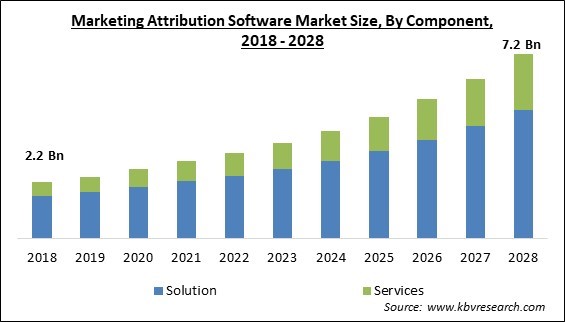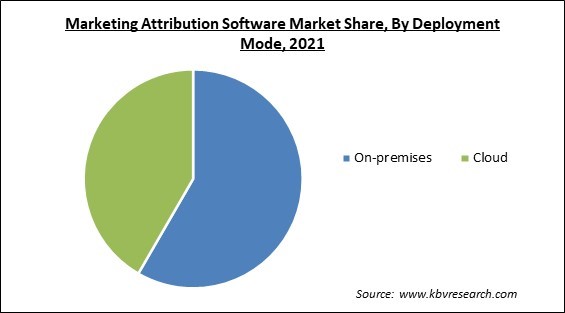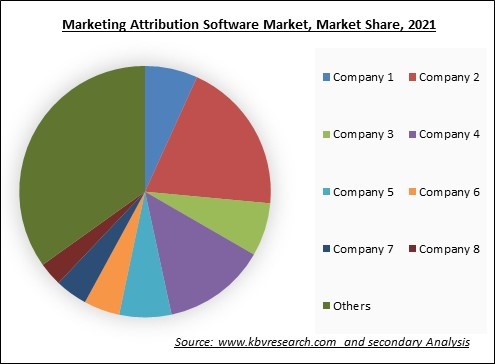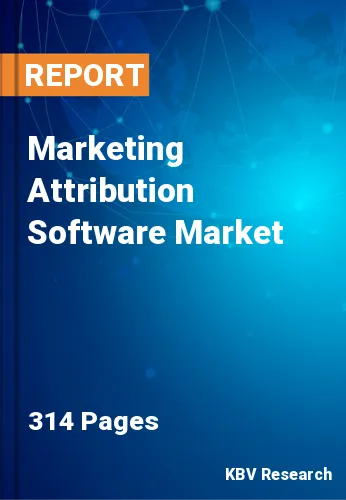The Global Marketing Attribution Software Market size is expected to reach $7.2 billion by 2028, rising at a market growth of 13.7% CAGR during the forecast period.
Companies employ marketing attribution software to identify the activities, occasions, or touchpoints that contribute to the effectiveness of their marketing and sales teams during the prospecting and sales processes. It's quite challenging to determine what made a closed deal effective because it frequently involves balancing several variables and circumstances that may occur in any sequence.

Based on the impact each factor had on the customer or prospect throughout their contacts with the business, companies utilize marketing attribution software to assign a value to each factor that might have contributed to the success of a sale. Since marketing attribution software frequently integrates with other marketing and software tools used by sales, marketing, or public relations departments, such as CRM, email marketing, demand generation, marketing automation, email tracking, or sales analytics tools, it is a hub software that gathers data from other marketing and software tools.
Marketing teams need cutting-edge analytics solutions that can precisely and quickly transform massive data into person-level insights that can be applied for in-campaign adjustments to attain the level of data granularity necessary for effective attribution. Marketing attribution is much more crucial because of the variety of this data and the sheer number of potential touchpoints. In addition, because analytical tools may pull information from various sources, the lessons from this attribution provide a complete view of business marketing performance and audience habits. When assessing marketing touchpoints, for instance, some analytical systems can consider asset kind, exposure order, and device type.
The COVID-19 pandemic has had a significant impact on enterprises all over the world. The lockdown imposed by many governments has benefited from adopting marketing attribution software. Companies are concentrating on developing technology after the COVID-19 incident, including AI-powered solutions, cloud computing, and automation. Also, companies are spending more on marketing attribution software due to the expanding popularity of personalized marketing as a strategy to improve the customer experience. The program also provides businesses with several advantages, such as the capacity to manage marketing budgets and assess the efficiency of marketing channels and campaigns.
The majority of enterprises are embracing cloud-based strategies by dispersing their resources across multiple environments. As a result, the popularity of cloud-based marketing attribution solutions has increased due to their adaptability, scalability, and low cost. It also enables enterprises to centrally evaluate data created from several places and acquire data from diverse applications or platforms, making data collection and analysis easier. In addition, it permits the tracking of billions of events every day, the use of machine learning to connect the dots between views and purchases, and the visualization of results for clients and teams inside the company.
It is essential for businesses to be able to take user behavior across devices into consideration as they continue to plow through the uncharted waters of digital marketing. Advertisers must be able to analyze data, accomplish cross-device attribution, and develop effective advertising strategies. This change in the purchasing journeys highlights the requirement for accurate attribution of the digital consumer's path, starting with product awareness, purchase consideration, loyalty to the product, and product advocacy.
As the use of SMAC technology has increased, companies require more rigorous security and privacy measures to prevent breaches, which, if not taken properly, can have a negative impact on the success of digitalization. As the amount of client data increases, so do the number of security & privacy concerns, making them increasingly vulnerable to hacker attacks. Data privacy & security is a crucial concern that must be adequately addressed. Additional security concerns, such as account hijacking, insider threats, insecure Application Programming Interfaces (APIs), malware injections, shared vulnerabilities, and data loss, are more common in cloud-based marketing automation software.
Based on type, the marketing attribution software market is segmented into multi-source attribution, probabilistic or algorithmic attribution, and single-source attribution. The probabilistic or algorithmic attribution segment covered a considerable revenue share in the marketing attribution software market in 2021. The segment's rise can be linked to the capacity of probabilistic or algorithmic attribution models to analyze, convert, and disqualify consumer trips. In addition, it helps determine which marketing channels have the highest impact and significance at various touch points along the customer journey.

By organization Size, the marketing attribution software market is bifurcated into large enterprises and small & medium-sized enterprises. The SMEs segment garnered a substantial revenue share in the marketing attribution software market in 2021. The segment's growth can be attributed to the global increase in the number of government programs, including digital SME marketing efforts.
On the basis of vertical, the marketing attribution software market is segmented into consumer goods & retail, IT & telecom, BFSI, media & entertainment, healthcare, travel & hospitality, and others. In 2021, the travel & hospitality segment procured a promising growth rate in the marketing attribution software market. With attribution, hotel brands can establish the value of the social initiative's reach and whether the investments in this area yield the appropriate return regarding room nights and revenue. In addition, the hotel marketer can comprehend how different types of social investments and individual campaigns within various networks have fundamentally distinct ROI characteristics.
Based on component, the marketing attribution software market is fragmented into solution and service. In 2021, the solution segment generated the maximum revenue share in the marketing attribution software market. Businesses frequently employ a multi-channel strategy for marketing and create marketing campaigns specific to each level of the funnel. Models of marketing attribution quantify the impact of digital campaign expenditures on business results. To aid firms, marketing attribution solutions assess channels according to their value to them. They also comprehend marketing channels.
Based on deployment mode, the marketing attribution software market is segmented into on-premise and cloud. This can be attributed to the many benefits that come with on-premise deployment, including a high level of data protection and safety. Because on-premise deployment models have higher data security and fewer data breaches than cloud-based deployment models, industries prefer them, which fuels industry demand for on-premise deployment models.
| Report Attribute | Details |
|---|---|
| Market size value in 2021 | USD 3 Billion |
| Market size forecast in 2028 | USD 7.2 Billion |
| Base Year | 2021 |
| Historical Period | 2018 to 2020 |
| Forecast Period | 2022 to 2028 |
| Revenue Growth Rate | CAGR of 13.7% from 2022 to 2028 |
| Number of Pages | 315 |
| Number of Table | 540 |
| Report coverage | Market Trends, Revenue Estimation and Forecast, Segmentation Analysis, Regional and Country Breakdown, Market Share Analysis, Companies Strategic Developments, Company Profiling |
| Segments covered | Component, Type, Deployment Mode, Organization Size, Vertical, Region |
| Country scope | US, Canada, Mexico, Germany, UK, France, Russia, Spain, Italy, China, Japan, India, South Korea, Singapore, Malaysia, Brazil, Argentina, UAE, Saudi Arabia, South Africa, Nigeria |
| Growth Drivers |
|
| Restraints |
|
Region wise, the marketing attribution software market is analyzed across North America, Europe, Asia Pacific, and LAMEA. In 2021, the North America region led the marketing attribution software market by generating the largest revenue share. In the BFSI, tourism, healthcare, and other industries, marketing attribution software solutions are being utilized increasingly frequently to enhance organizations and the customer experience. The market for marketing attribution software in North America is anticipated to benefit from these lucrative growth potentials.
Free Valuable Insights: Global Marketing Attribution Software Market size to reach USD 7.2 Billion by 2028

The leading players in the market are competing with diverse innovative offerings to remain competitive in the market. The illustration shows the percentage of revenue shared by some of the leading companies in the market. The leading players of the market are adopting various strategies in order to cater demand coming from the different industries. The key developmental strategies in the market are Acquisitions, and Partnerships & Collaborations.
The market research report covers the analysis of key stake holders of the market. Key companies profiled in the report include Oracle Corporation, Google LLC (Alphabet, Inc.), SAP SE, Adobe, Inc., Merkle Inc. (Dentsu Group Inc.), Neustar, Inc. (TransUnion LLC), HubSpot, Inc., Nielsen Holdings plc (Elliott Investment Management L.P.), Ruler Analytics Limited, and Windsor Group AG
By Component
By Type
By Deployment Mode
By Organization Size
By Vertical
By Geography
The global Marketing Attribution Software Market size is expected to reach $7.2 billion by 2028.
Monitoring client behavior for targeted marketing are driving the market in coming years, however, Concerns regarding privacy & security restraints the growth of the market.
Oracle Corporation, Google LLC (Alphabet, Inc.), SAP SE, Adobe, Inc., Merkle Inc. (Dentsu Group Inc.), Neustar, Inc. (TransUnion LLC), HubSpot, Inc., Nielsen Holdings plc (Elliott Investment Management L.P.), Ruler Analytics Limited, and Windsor Group AG
The Large Enterprises segment is generating highest revenue share in the Global Marketing Attribution Software Market by Organization Size in 2021, and would continue to be a dominant market till 2028; thereby, achieving a market value of $4,746.5 million by 2028.
The Multi-source Attribution segment is leading the Global Marketing Attribution Software Market by Type in 2021 thereby, achieving a market value of $3.6 billion by 2028.
The North America market dominated the Global Marketing Attribution Software Market by Region in 2021, and would continue to be a dominant market till 2028; thereby, achieving a market value of $2.4 billion by 2028.
Our team of dedicated experts can provide you with attractive expansion opportunities for your business.

